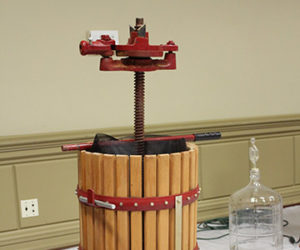Every winemaker should learn the basics behind sulfites. Understanding when and where sulfur dioxide (SO2) should be used is helpful for every winemaker looking to produce better wines. Winemakers use sulfur dioxide for sanitation purposes and as a preservative to ward off the ill-effects of oxidative damage and microbial invasion. Unfortunately there are still some lingering rumors among the wine drinking crowds regarding the side-effects of sulfites on their health, so let’s start there.
Stick with the facts
Many folks claim sulfites cause headaches for wine drinkers. This is just a myth! While drinking wine can cause headaches, it is more likely due to the alcohol or the tannins or the histamines found naturally occurring in wine – not the sulfites. A very small percentage of folks do have allergies to sulfites and those are associated with asthma. It is estimated that between 1-5% of sufferers of asthma have an allergy to sulfites. With that said, wine in general contains about 1⁄10th the level of sulfites found in dried fruits. If you can consume dried fruit without problems, then sulfites from wine should not be a problem.
Potassium metabisulfite (KMS or K2S2O5) is the chemical name of the salt that will provide the sulfur dioxide for winemakers. Most winemakers will purchase their KMS in one of two forms, either as a salt that comes in a bag or bucket or as pre-formed tablets known as Campden tablets. The Campden tablets are easy and predictable for winemakers. Larger bags of tablets can be purchased and each tablet weighs 0.44 g. Roughly 10 tablets (KMS + filler) equates out to 1 tsp. of KMS salt. Tablets can be cut or crushed if incremental amounts need to be utilized.
Sanitation purposes
Sulfur dioxide is a great sanitizer when used in conjunction with proper cleaning practices. Do not substitute a SO2 soak with a proper cleaning of your equipment. Cleaning is done with a cleaning agent such as sodium percarbonate. Sanitizing can then follow with an SO2 solution.
To make a sanitizing solution, start with making up a 10% solution of KMS. Mix together at a rate of 100 g of KMS to half a liter of cold water, then top up with cold water to make 1 L of total solution. Do not use hot water or the sulfur fumes can burn your airway passages, cold water will help keep these fumes down. This solution can be stored for several months in a sealed container placed in a cool spot. When ready for use, simply dilute the sulfur solution with cold water in a 1:1 ratio to your intended volume. Once diluted you can place the 5% solution in a spray bottle for equipment or to soak items such as corks, carboys, bottles, etc.
Protection purposes
When it comes to using sulfur dioxide for protective reasons, there are a large number of factors that need to be considered. First off you need to figure out if you even want your wine to be protected at that point and time of production. Generally speaking, pre-fermentation must will benefit from limited exposure to oxygen, which the sulfites may prevent, so sulfite additions are generally avoided unless crushed grapes or juice is being stored. Post-fermentation wine will generally require some level of protection and therefore will benefit from a sulfite addition. But there are many variables such as pH, sugar content, temperature, alcohol percentage, whether it is red or white wine, current levels of sulfite in the wine, desired levels of sulfite – that will control exactly how much KMS to add.
To get a handle of how much sulfite you will want to add, you need a way to measure out the sulfite and a good sulfite calculator. A quality scale, such as a jeweler’s scale can be very helpful to precisely measure out the KMS salts if you do purchase a bag. Otherwise Campden tablets are a good route to go.
A good sulfite calculator is an invaluable tool when used properly by winemakers. Luckily for us, Daniel Pambianchi created just such a tool and it can be found on our website at winemakermag.com/sulfitecalculator. It is fairly simple and intuitive, but still I urge beginning winemakers to gain practice with the tool before using it in a real life situation. Simply make up a few imaginary batches of wine with numbers found in WineMaker magazine or online to understand how the different factors can play a big role in determining just how much SO2 protection you need. This will lead you down the wormhole of learning about free SO2 and molecular SO2. But understanding sulfite additions will ultimately help you gain an upper hand on potential microbial invaders or oxidation.







